Support The Crespogram
NUMBER 93 - JUNE 20, 2019
IGNORED IN ALL OF THE FEEL GOOD PRONOUNCEMENTS BY MIAMI'S POLITICIANS ABOUT RESILIENCE AND THE MANAGEMENT OF SEA LEVEL RISE LURKS THE MULTI-BILLION DOLLAR COST OF DEALING WITH THE 104,000 PROPERTIES IN THE COUNTY THAT USE SEPTIC TANKS
Miami is not the only large costal city in the world that experts claim will be hard hit as sea level rise continues. London and Tokyo, along with Miami were featured in a recent PBS series titled Sinking Cities, because they, along with Miami are considered to be the three cities most in danger.
While all three of these cities shared many of the same problems, the episodes that focused on London and Tokyo revealed that both of those cities had seriously started trying to deal with their problems years ago, unlike Miami and the other municipalities in Miami-Dade County who have for a multitide of reasons chose to ignore or downplay the problems and costs required to do more than engage in the shortest of short term patch jobs that will not stop large parts of South Florida from becoming unlivable.
The problems that South Florida faces requires a lot more than the political posturing of nitwit politicians looking for cheap answers and involves fixes that will cost a lot more than either the politicians or the public have so far been willing to spend.
Only this weekend, WSVN featured a story about a car being flooded off of Biscayne Boulevard and NE 23rd Street, and the water was high enough to reach the top of the car seats.
That's 23rd Street and Biscayne Boulevard, a block or so away from Norman Braman's car dealerships.
If the streets in Edgewater are now flooding as a result of summertime rain, what will happen if a level 3-4-or 5 hurricane shows up with the kind of rain component that hit Huston several years ago.
How badly will Miami be hurt by flooding if 10-15-or 20 inches of rain falls, much less 30-40 or 50 inches? This level of flooding will cause far more long-term damage than the flooding caused by a day of summetime rain, and the biggest and most lasting damage could be to our drinking water.
In their latest effort to convince the public that they are on top of the threat of sea level rise, the Mayors of Miami-Dade County, the City of Miami and Miami Beach recently issued a press release with the title:
Greater Miami & the Beaches Unveils a 21st Century Model for Urban Resilience with Support of Mayors Throughout the County.
The press release, written in convoluted government speak, was a mishmash attempt to lump many of the region's disparate problems - including problems unrelated to sea level rise - into a self-serving collection of platitudes that ignored any mention of the costs associated with the real problems facing South Florida as a result of sea level rise, and then wrapping it up in a nice sound bite from Boy-Toy Mayor Francis Suarez:

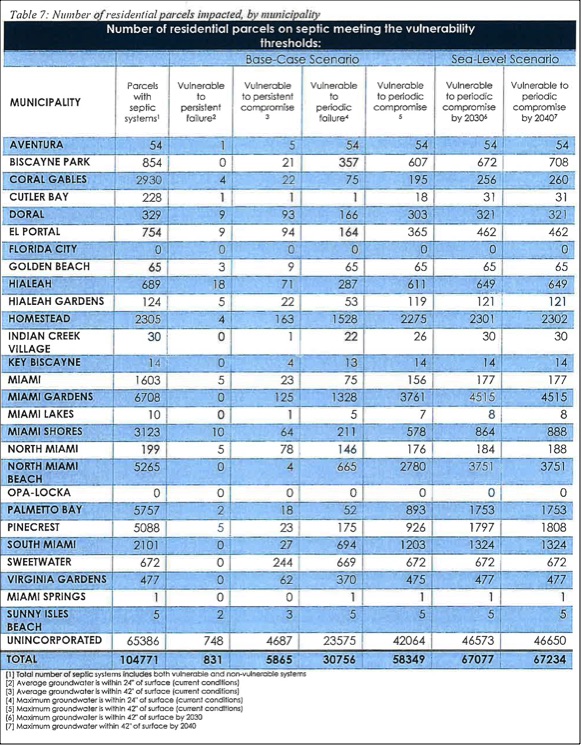


Leave it to Francis Suarez to prattle about Miami serving as a model for the world.
The only thing that many people would claim that Miami has ever provided as a model for the world besides the fact that some Miami politicians are as crazy, if not crazier than any politicians anywhere else is medicare fraud, the laundering of cocaine profits, and providing a safe haven for the kleptocratic gangsters in foreign countries who steal money from their government's coffers and invest it in Miami real estate.
THE SMELL OF SEWAGE AFTER A HARD RAIN
In addition to the persistent and increased flooding of Miami streets after a hard rain, the smell of raw sewage is also beginning to be noticed by folks in some neighborhoods, especially in the South Grove, where milti-million dollars homes sit atop septic tanks that are obviously leaking raw sewage into the ground.
The problem is not limited to just the South Grove. The coastline of Miami-Dade County has a number of very expensive homes along Biscayne Bay whose septic tanks are affected by heavy rains and King Tides.
On May 1st I did a story that included a detailed description of the number of residential properties in the county that might be affected by seal level rise.
In that story I focused on Miami Shores, but in reality when you look at the list of municipalities and the number of homes and commercial properties that use septic tanks - 104,771 - you realize that just the number of properties that are claimed to be vulnerable to periodic failure or compromise - a total of approximately 83,000 - represent a catastrophe waiting to happen.
It would seem from the deafening silence by politicians across the county how petrified they are to talk about the ramifications of this septic tank problem, or to publicly acknowledge the costs to their communities associated with fixing the problem.
In the 2018 report issued by the county: Septic Systems Vulnerable To Sea level Rise (The report is at the bottom of this story,) the reported came up with a cost of approximately $3.3 BILLION. (Page 8)

Vulnerability Septic Systems Sea Level Rise 1 by al_crespo on Scribd
What is confusing is that the $3.3 BILLION in costs cited above is what the county estimates it would cost to complete the conversion of properties with septic tanks to sewer in the following communities:
Coral Gables Bal Harbor Bal Harbor Island
Florida City Hialeah Hialeah Gardens
Medley Homestead Indian Creek
Miami Beach North Miami North Bay Village
Opa-Locka Surfside North Miami Beach
West Miami Virginia Gardens
The explanation for this is that the above municipalities are already hooked up to the county's sewer system, and the $3.3 BILLION is what it is estimated it would cost to link up the properties within these municipalities that were never converted over to sewer from septic tanks.
All of the other municipalities in the county that are not listed aboce, like Miami Shores, El Portal, Biscayne Park, Pinecrest, Palmetto Bay, Miami Lakes, Miami Gardens, Cutler Bay, Aventura and the City of Miami are not part of the county's regional water system, and those municipalities would be responsible for covering the total costs of linking up to the county's sewer system which would include paying for the sewer pipes in the road, hookups to pumping stations, and the residents, on top of covering those costs - which in most, if not all instances would require issuing general obligations bonds or setting up a Special Taxing District - would also be personally responsible for the costs of the hookups from their properties to the pipes in the street.
As just one example, and it's an example that I requested because I live in Miami Shores, the costs associated with converting Miami Shores from septic tanks to sewer would cost approximately $85,450.00, excluding the individual costs of each property owner for the hookup from their property to the sewer pipes running down their streets.
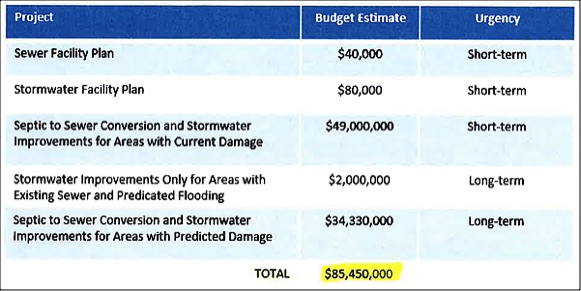
Because Miami Shores residents, by a wide margin voted down a $20 million bond issue to build a new Recreation Center in 2015, it's hard to see an $85 million general obligation bond issue passing, especially when they are now grappling with having been recently informed that they will be subjected to an almost 90% increase in their Solid Waste Collection and Disposal fees over the next ten years.
In fact, it's hard to imagine that many of these communities would energetically leap forward to insure the costs of bond issues with similar costs to what is facing Miami Shores.
And its not just the costs that represent a problem. The time involved from convincing the voters to approve such a bon issue, to planning, permits construction and individual property hookups could easily stretch to a decade or more.
WHY DO SEPTIC TANKS REPRESENT SUCH A PROBLEM
It would almost seem that the problems of septic tanks would be self-explanatory, but unfortunately a lot of people still are unfamiliar with the mechanics of what happens to raw sewage after they flush a toilet.
In an article written for the August 29, 2018, Bloomberg Business Week, Christopher Flavelle, detailed the problems that South Florida faces with it's septic tank problems.
Here is a small excerpt from that article. I would urge you to take the time and read the entire article by clicking on the link above.
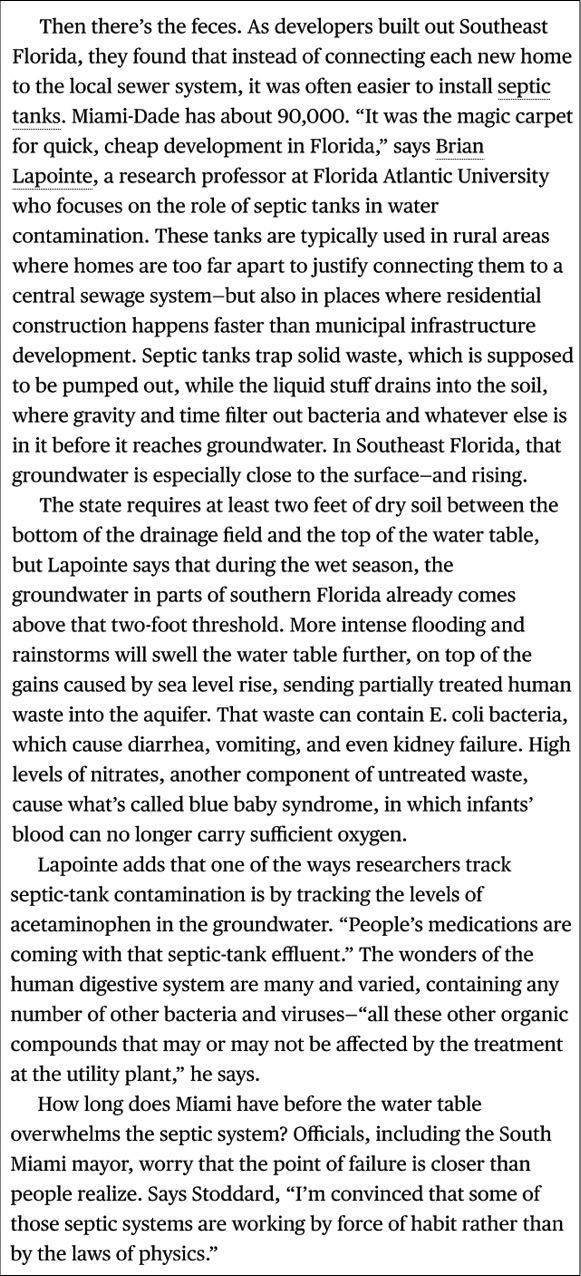
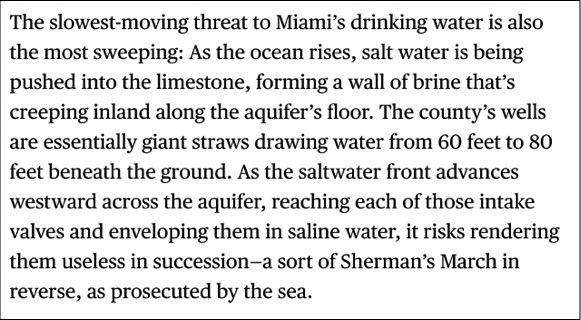
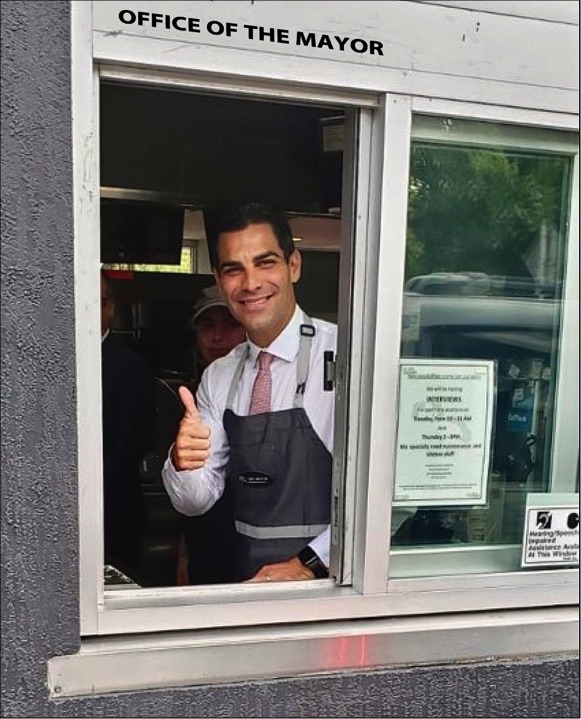
PHOTO OF THE DAY - ALWAYS FOCUSED ON PROVIDING PERSONALIZED SERVICE TO HIS CAMPAIGN DONORS AND LEGAL CLIENTS, MIAMI'S MAYOR FRANCIS SUAREZ HAS OPENED A DRIVE-THROUGH WINDOW. WHOPPERS ARE ON THE HOUSE
The other long-term problem that everyone in South Florida faces is salt water intrusion.
This problem is so severe that US Geological Survey has set up a website where you can track salt water intrusion into all of the aquifers of all of South Florida. The site is well worth a visit.
For now, the only short-term measure that homeowners who have septic tanks can take is to start monitoring and servicing their septic tanks on a regular basis.
That failure is at the forefront of the reason why some streets in the South Grove smell like raw sewage now, and why other areas of the county start smelling like sewage every time there is any significant rain fall.
It's Miami. Bitches!
HERE ARE TWO REPORTS ISSUED BY THE COUNTY THAT PROVIDE MORE INFORMATION ON THE PROBLEM OF SEPTIC TANKS
Keep in mind that here reports are essentially works in progress that will lead to new reports as new information is acquired.
Tetra Tech 2016-Identificat... by on Scribd
Copyrighted: 2011,2012, 2013, 2014, 2015, 2016, 2017, 2018, 2019



